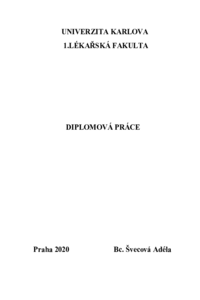Využití jednotlivých typů polohování u pacientů po cévní mozkové příhodě v akutní a subakutní fázi rehabilitace z pohledu ergoterapie
Use of individual types of positioning on patients after stroke in the acute and subacute phase of rehabilitation from the perspective of occupational therapy
diplomová práce (OBHÁJENO)

Zobrazit/
Trvalý odkaz
http://hdl.handle.net/20.500.11956/120203Identifikátory
SIS: 198886
Kolekce
- Kvalifikační práce [4870]
Autor
Vedoucí práce
Oponent práce
Kuželková, Anna
Fakulta / součást
1. lékařská fakulta
Obor
Ergoterapie
Katedra / ústav / klinika
Klinika rehabilitačního lékařství 1. LF UK a VFN v Praze
Datum obhajoby
22. 6. 2020
Nakladatel
Univerzita Karlova, 1. lékařská fakultaJazyk
Čeština
Známka
Dobře
Klíčová slova (česky)
cévní mozková příhoda, polohování, ergoterapeut, iktové centrumKlíčová slova (anglicky)
stroke, positioning, occupational therapist, stroke centerDIPLOMOVÉ PRÁCE Jméno a příjmení: Adéla Švecová Vedoucí práce: Mgr. et Mgr. Jaromíra Uhlířová Název diplomové práce: Využití jednotlivých typů polohování u pacientů po cévní mozkové příhodě v akutní a subakutní fázi rehabilitace z pohledu ergoterapie. Cévní mozková příhoda je jedním z onemocnění nejvíce ovlivňující lidskou populaci. Jejím důsledkem může být dočasné postižení, trvalé následky i smrt. Polohování pacienta po cévní mozkové příhodě může mnoho rizik sekundárních změn ovlivnit. Cílem této práce je zjistit, jak se ergoterapeuti zapojují do polohování pacientů v akutní a subakutní fázi po cévní mozkové příhodě v iktových centrech v České republice a jak polohování na iktových centrech probíhá. Z literatury a doporučených postupů vyplývá, že správným polohováním po cévní mozkové příhodě v akutní a subakutní fázi je předcházeno vzniku imobilizačního syndromu a sekundárních změn. Polohováním pacientů po cévní mozkové příhodě lze ovlivnit svalový tonus, bolestivost ramene, předcházet subluxaci v kloubech, udržet pasivní i aktivní rozsah v kloubech atd. U pacientů po cévní mozkové příhodě by měly přicházet vzruchy z postižené strany pro podporu návratu senzomotorických funkcí a pro zapojení postižené strany do aktivit. Ergoterapeut se nejvíce zapojuje při polohování postižené horní končetiny...
OF MASTER THESIS Tittle of master thesis: Use of individual types of positioning on patients after stroke in the acute and subacute phase of rehabilitation from the perspective of occupational therapy. Stroke is one of the diseases that most affects the human population. It can result in temporary disability, permanent consequences and death. The patient's positioning after a stroke can affect many risks of secondary changes. The aim of this work is to find out how occupational therapists are involved in the positioning of patients in the acute and subacute phase after a stroke in stroke centers in the Czech Republic and how the positioning in stroke centers takes place. The literature and recommended procedures show that the correct positioning after a stroke in the acute and subacute phase prevents the development of immobilization syndrome and secondary changes. Positioning patients after a stroke can affect muscle tone, shoulder pain, prevent subluxation in the joints, maintain passive and active range in the joints, etc. In patients after a stroke, agitation should occur from the affected side to support the return of sensorimotor functions and to involve the affected parties to activities. The occupational therapist is most involved in positioning the affected upper limb, especially to...
